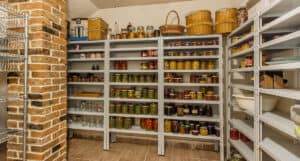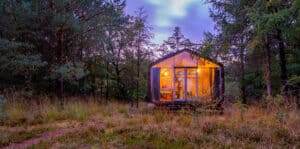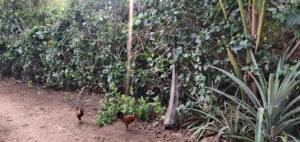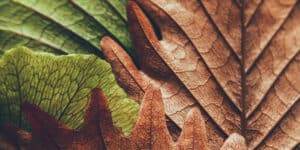“Winter is coming” was always a famous saying around our house, long before Game of Thrones. No matter what, if you live in a cold climate, at some point, you prepare for winter, whether switching out summer clothes for winter wear or putting on snow tires; We have to prepare for the cold, ice, and everything in between. As homesteaders, we can spend much of the year preparing for the long winter months, but what does a homesteader do in the winter time?
Because we spend so much time preparing for winter, there is often a misconception that during winter, we can relax and hide away until spring. I don’t know where this notion came from, but winter is the most productive time of the year because we have the time to accomplish all that we don’t have time for during the warmer seasons.
All summer long, I forage, garden, and process medicinal plants; Those tasks keep me busy enough without making those items into tinctures, candles, soaps, etc. Instead, I save those tasks for winter when I can keep track of my inventory and plan for the next season. Whether you are a homesteader or not, winter can be a time when we can plan and prepare for the following year. Too often, we get trapped in the same old routine; imagine if, every winter, you took on a new learning journey and tried a new hobby or project.
As homesteaders, we can use this time to upgrade our skills and knowledge as well as much-needed and deserved self-care. I dread going outside in minus twenty to feed the chickens or walk the dogs; By focusing on the positive tasks, I can look forward to making winter the best time of the year, rather than dreading it. Below you’ll find tons of tasks, project ideas, chores, and preparation ideas to help you keep busy and stay motivated during the winter.
Homesteading in the winter home and yard to-do list
Every house and property will be different, yet there are always some everyday tasks that we can all do to be prepared.
What to do around the house
New or old, check your windows, foundation, skirting, chimney seals, and exposed utility boxes for any damage and leaks. If needed, seal or secure for prevention. Cover any areas around the house that are not insulated with extra layers, whether plastic, foam, or insulation; adding additional layers might bring condensation issues later on; remember to take precautions such as vapor, barrier, and sealing all leaks. Snow fencing or windbreak walls can be constructed for added protection. Deep snow can be used as additional insulation; However, remember in the spring to remove it before it floods the basement or open ground beneath your house.
Animals care during the winter
like you, your animals need to be warm, fed, watered, and kept busy. Larger animals will need to get outside regularly for exercise; be sure you always have a clearing for them. Large or small all animals should have an insulated space to hide from the cold and sleep. Light is low during the winter; adding additional light will benefit animals, especially in production, like chickens or milking animals. Food and water are essential. Be sure there is dry space for storage, free of pests, and access to water. Create a schedule for daily animal care and interaction; animals need mental stimulation and company, just like you. Viste and give them things or activities to keep them busy. Some animals like balls or shiny objects, while others enjoy the food, they can eat and play with. Entertain your animals. I promise you they won’t be the only ones enjoying that time.
Barns, sheds, and storage places
Winter is a great time for organizing and deep cleaning in storage spaces that don’t house animals. Consider making the time to get on track with your storage, overstock areas, and cleaning out spaces to get ready and fresh for next season. I collect egg cartons and boxes for products. They pile up and get disorganized. I can count and organize what I have into a manageable pile during winter. Reorganize the tool shed, sweep out the cobwebs, restack straw, sweep spilled feed, break down boxes, eliminate junk taking up space, etc.
The yard and driveway
It is a good idea to put up snow fencing, driveway markers, and additional lighting before winter gets too dark and cold. If you have flood-prone areas, dig our drainage before the freeze and thaw. Ensure you can quickly clear and access your way in and out of your property. Now is a good time to double-check your winter equipment and ensure backup fuel and oil. Finally, be ready for winter storms before they happen.
Wood and energy
Hopefully, you are stocked enough with wood for heating during the winter. However, there is still work that needs to be done. Keeping wood dry is a primary concern for those who store wood outside or in an open dry shed; rain, ice, and snow can remoisten dry wood, which is not good if that is your only source for heating and cooking. Regularly rotate wood, bring as much as you can inside, and cover what you are not using. Besides the wood pile, solar panels also need to be regularly checked. Have a gentle snow broom handy to keep panels wiped off and clean them on warm days.
Winter homesteading garden tasks and planning
Garden planning is vital for an abundant season, and we start planning and designing during the winter.
Garden Planning
Crop rotation is crucial for soil health; that is why whether you are a farmer or have a small backyard garden rotating what you plant and where every single year will keep your garden soil healthy, alongside practices like amending and fertilizing. That means you can redesign your garden every year with a new plan, especially if you have a southern-facing yard where you are not limited to specific locations for particular plants. For example, if you only get 5 hours of sun on one side of your yard, that space may not grow tomatoes as well as carrots or potatoes; rotating and planning will require a bit more creativity, yet still necessary for a healthy garden.
Take the time to draw a map of your garden. If you still need to make one from last year, draw two. One is showing this year’s garden, and the new drawing you can redesign for next season’s plan. Make notes about what new seeds you want to grow, perennials you plan to plant, and any other reminders or goals you want for your next growing season. I find this a fun task, I will even pull out the colored pencils and get creative, but if you are not into drawing, there are plenty of online programs and apps to help you design the perfect garden.
Collecting seeds and propagating plants
Once you have a garden plan, you can work on obtaining the seeds you need. After checking the seeds, you have already been saving and can now list what you need. Winter is the perfect time to order seeds, search online or get some catalogs and place your orders as soon as possible. In the past few years, seeds have sold out faster than ever. So you’ll want to start ordering immediately, especially if you are ordering rare seeds. Alternatively, you can find other ways to source seeds, saving them from the organic food you are already purchasing or, better yet, the food you have grown. Locally grown produce is a good option for seed saving because the seeds are already climatized and should grow without trouble in your garden. Ask the farmer if you need more information.
My Neighbour always buys organic pineapples, and then she regrows them; they are crazy massive and can take a couple of years to reach maturity, but still, the point remains, she’s regrowing pineapple. You can regrow many fruits and vegetables, which I often do for winter harvest and to get a start on the garden. Stick to organic produce because some GMO foods will regrow but not produce a viable fruit or vegetable. Celery takes a long time to reach maturity, longer than my growing season, and I will usually buy some organic celery in late winter, cut off a 1–2-inch piece of the bottom, eat the rest, of course, then place the base in water and watch it grow. Once spring arrives, I will have a nicely rooted large celery ready to eat or plant, no seeds required. For example, many root vegetables can regrow new plants like ginger root. One inch of ginger root planted in the soil will regrow a new ginger plant, perfect to start in the winter. Ginger is a warm climate plant that needs ten months of growth; starting it during the winter will give you are large healthy plant to work with when it comes time to move it outside or plant in the ground. e
Tools, equipment, and composting
Before spring arrives, clean garden tools like hand shovels and gloves, pots, and seedling trays. If you have diseases like powdery mold or blight residue that might be left on tools and equipment, ensure everything gets washed before reusing.
Composting is tricky during winter but possible. Most compost will not decompose during cold or freezing temperatures; smaller indoor options, especially with worms, such as vermiculture, will allow you to continue composting food waste during the winter. Of course, you can always feed your compost and wait for spring to do all the work, but why wait when you can have fun with worms now? Lol!
Vermiculture is a couple of bins or boxes with holes for air and drainage and is full of thousands, yes, thousands of worms. They do all the hard work of turning plant food waste into black gold or amazing nutrient-rich soil. The liquid produced creates additional fertilizer in a concentrated form. One of these systems is an excellent option if you want soil ready to use come spring. You can purchase them online or, better yet, make one as a fun winter project. Worms should be bought from a local supplier or can be ordered online. Search for a supplier that deals in your country. Live animals won’t be shipped across borders.
Growing winter crops
Growing winter crops requires a frost-free location outside, like a heated greenhouse or inground winterized greenhouse, or growing indoors can be an option. You will need sufficient light, warmth, and space regardless of where you grow. Hardey crops like cabbage, lettuce, and some root vegetables will thrive in cold conditions and grow best outside as long as there is no direct frost and temps stay above freezing; these are good choices for an outdoor winter greenhouse. Indoors or with a heated greenhouse, you have more growing options. Winter is a great time to explore some of these alternative growing methods.
Growing food under lights or supplementing light during low light days, you can grow just about anything that can be hand pollinated if you have the space and can provide nutrients and air circulation. Small indoor growing can produce fresh herbs, micro greens, tomatoes, lettuce, and more. Consider adding indoor gardening to this winter’s activity list.
Healthy homestead practices to try this winter
Winter is the perfect time to make and stock up on herbal medicine, homemade cleaners, and personal care items. You can use homegrown and foraged ingredients or purchased ingredients to make all the cleaners, soaps, and skin care items you would typically buy.
Making cleaners, personal care products,
Homemade cleaners are easy to make and can be made with many ingredients found around your house. A good disinfectant cleaner usually has an acid or alcohol base. Vinegar is one option for a safe acid, and rubbing alcohol or isopropyl makes a perfect alcohol ingredient; both are cheap and are usually readily available. I will soak citrus peels in vinegar to make an all-purpose cleaner base; adding a little alcohol doubles the disinfecting power.
Baking soda is another all-purpose ingredient most of us have or can easily purchase. If you’re looking for scrubbing action, baking soda is a soft yet abrasive powder that cleans many surfaces easily without damage. Once you use baking soda for cleaning, you may also notice how soft your hands feel, These ingredients s also used in many body scrubs, bath salts, and foot soaks.
Simple ingredients can be used to create all kinds of lavish bath salts, soaps, and creams. You could make a few recipes to replace the store-bought versions you are used to. We get dry skin from using a woodstove for heat, so I tend to make more lotion bars and balms, which are easy to make. You can choose skin-safe essential oils for added scents, or better yet, make your infusion with flowers and herbs you grow yourself. Herbalism isn’t just about making medicine. Imagine having your own line of rose cream and soaps made in your kitchen.
Medicine at home
If you are interested in making medicine, why not start while it is cold and flu season? Home remedies are natural solutions that we can use or add to our healthcare routines. Making tinctures and syrups can be time-consuming; Winter is the perfect time to start your brews and tonics, and it could be an excellent time to learn about ingredients you already have around your kitchen. Explore the spice shelves and pantry. I bet you will discover lots of medicine already in stock. Thyme is excellent for coughs and colds, ginger for nausea, honey for wounds, onions to expel mucus, and so many more remedies lingering in your kitchen. Winter can be the time for learning how to heal naturally.
Selfcare and wellness
Making time for self-care is essential for overall health and mental well-being; make sure that even if you are not making any self-care items, you take the time to relax in whatever way that looks like for you besides TV. Anyone can do that. Make time to quiet your mind and rest your body. I promise this will help you stay positive and energized during low light days and when melancholy sets in, which is just a natural reaction to less vitamin D. Winter can be about self-healing, so take advantage of this time for yourself.
Classic homesteading hobbies perfect for cold winter nights
The days are short and cold; as we spend more of our evenings inside the house, we can use this time to be productive and create, build or fix things for ourselves, our homes, or give as gifts.
Homemade crafts, gifts, carpentry, and remodeling,
Quilting, sewing, knitting, and crocheting are just a few common and classic homesteading hobbies that many people enjoy. These skills used to be a necessity. If you didn’t sew, you wouldn’t have had quilts, dresses, etc. We don’t live in those times, so you get to choose what hobbies to try. Some of these are good to have but not necessary.
Making, baking, fixing, building, designing, writing, whatever your passion or interest, make the time for it during winter. Fix the leaky sink, paint that masterpiece, sew some curtains, become a cookie decorator, and use winter to do the things we don’t have time for the rest of the year. While making, baking, fixing, and creating, why not use some of these items and skills to give as gifts or use gift-giving as an excuse to get busy? As I said, I make lotion bars and balms for myself; they also make great gifts, and people love homemade things.
Remodeling, decluttering, and reorganizing can all be things to keep you busy as well if you are not into crafty things. There are plenty of things you want to do or fix around the house, so why not make time for them this winter?
An Inspired homesteader is always learning
Learning survival and self-sufficient skills during the winter is a great way to become more self-reliant and learn potential skills for earning a living or improving the quality of life, as homesteaders’ learning is vital for the ongoing success and sustainability of this lifestyle. However, as modern homesteaders, you get to choose which skills will benefit you the most, whether for health, income, personal growth, or all three.
The more skills we can learn and practice, the more self-reliant we can become, which at the end of the day, is the ultimate goal for most homesteaders. Learning is part of preparing and planning; my daughter recently said she wanted to make cheese and butter at home one day when she had a cow; my response was, why wait to get a cow? I sent her a link to making cheese and butter at home and encouraged her to buy some organic milk for practice. We often wait to do or even learn because of trivial details; this is the perfect time of the year to learn and put knowledge into action. I’m hoping for some beehives next season. While I have the time during the evening, I read and learn about beekeeping.
Homesteading is about building the self-reliant lifestyle that you want, making the time to improve and build on the skills you already have, and getting inspired by others. Not every homesteader needs to learn how to make yogurt and sourdough bread, and you get to choose. When uncertain about what to do or learn next, search for inspiration, watch and listen to other homesteaders who can motivate you to take action and may inspire new ideas and thoughts. Take action this winter, learn, prep, plan, and get inspired.








